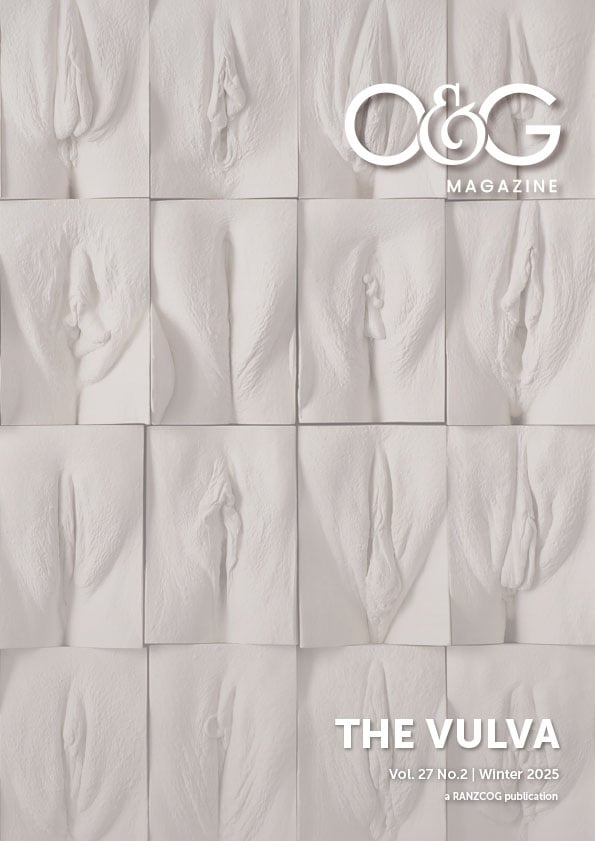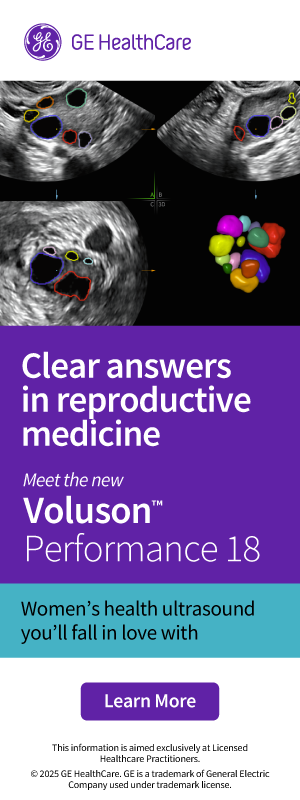A 57-year-old female presented with bothersome and progressively worsening lower urinary tract symptoms. Symptoms included continuous dribbling, leakage, and mild stress urinary incontinence. The patient required continuous use of incontinence pads, which were consistently saturated by the end of the day.
The patients’ medical history is of smoking one pack a day for thirty years, obesity, depression, hypertension and hypercholesterolemia, diabetes mellitus and recent intentional weight loss of 13 kg. Her medications are venlafaxine, amlodipine, rosuvastatin, metoprolol and gabapentin. Her obstetric history includes one child delivered via lower segment caesarean section; she has no other surgical history. She has been post-menopausal for seven years.
Prior to specialist referral a pelvic ultrasound was performed. It revealed a multiloculated cystic mass in the vagina. The smallest lesion was nearly collapsed, the 2 larger individual cysts measure 2cm on the right and 1.8cm on the left (see figure 1).
Vaginal examination revealed a midline mass approximately 2-3cm in diameterand appeared to be abutting the urethra. The mass was soft and did not discharge with gentle pressure, raising suspicion for a diverticulum. An MRI was performed for diagnosis confirmation and surgical planning.
MRI confirmed a multilocular cystic lesion 2.3 x 2.4 x 1.9cm posterior lateral to the mid to distal urethra. There was no solid component and no obvious urethral connection, most consistent with urethral diverticulum (see figure 2).
The patient was counselled on management options and scheduled for a diverticulectomy. A cystoscopy was performed prior to the surgery. Cystoscopy confirmed a normal bladder and a small area likely to be the communication within the urethra. The surgery was performed with an inverted U incision and a combination of sharp and blunt dissection to excise the diverticulum. Care was taken to avoid breaching the diverticulum during dissection. The urethra was entered during the surgery and closed over with 3.0 vicryl. After excision of the diverticulum the vagina was closed with 2.0 vicryl suture. A catheter was left in situ postoperatively. The patient was discharged home with a catheter for 4 weeks post-surgery. Her post operative recovery was uneventful.
Interestingly the histopathology revealed a urethral diverticulum with chronic inflammation, mucosal ulceration, and an incidental finding of nephrogenic adenoma.
The patient reports no recurrence of symptoms at 12 months follow up. We report this unique case of a nephrogenic adenoma occurring in a urethral diverticulum of a female patient.
Discussion
This case represents a unique instance of a patient presenting with urinary symptoms and a vaginal mass. This case leads to the discussion of an uncommon diagnosis of a urethral diverticulum, coupled with a rare histopathology finding of a Nephrogenic adenoma in a female.
Urethral diverticulum (UD) is an outpouching of the urethral mucosa into the peri urethral tissue. They are uncommon, occurring at a rate of 0.6-6%.1 The first case of UD was reported in the early nineteenth century, the frequency of diagnosis has been increasing with more sensitive imaging modalities.2
UD are most likely to be secondary to an infection of the peri urethral gland leading to gland obstruction, local abscess formation with eventual rupture into the urethral lumen.2 Some theories support a congenital aetiology, including faulty union of primordial folds, genesis from cell rests or Gartner’s duct remnants, and Mullerian remnants causing vaginal cysts.2
Urethral diverticulum can be challenging to diagnose. They can present with a range of symptoms including urinary incontinence, pelvic and urethral pain, urinary tract infections, a vaginal or pelvic mass, vaginal or urethral discharge, urinary urgency, frequency, or hesitancy. There is a classic triad known as the ‘3D’s’ dysuria, dyspareunia and dribbling however, this is not necessary for diagnosis.1,2
Diverticula typically appear on the middle to distal urethra in varied size, shape and location.1 Patients with UD may present with vaginal wall tenderness with or without a palpable mass. Digital pressure may express purulent or bloody discharge.2 The gold standard for diagnosis of a urethral diverticulum is magnetic resonance imaging (MRI).1 MRI has advantages over ultrasound or urethroscopy as it allows better visualisation of diverticular that may be small or non-communicating. The multiplanar resolution of an MRI allows for improved differentiation between normal anatomical variants, soft tissue masses and urethral pathology, which improves detection rates of diverticula.3
While the majority of UDs are benign, malignant change has been reported in 6-9% of cases.3 The most common neoplasm reported is adenocarcinoma, however transitional cell carcinoma and squamous cell carcinomas have been identified.2 Rare cases are reported of Nephrogenic adenoma.
Nephrogenic adenoma (NA) is a rare, benign lesion of urothelial proliferation. It can involve any segment to the urothelial tract.4-7 Nephrogenic adenoma usually arise in the urinary bladder (80%), typically confined to the lamina propria, and occasionally focally involve superficial muscular propria.6 They can involve the urethra (15%), the ureter (5%), and rarely the renal pelvis. Case reports exist of NA in urethral diverticulum.6 Nephrogenic adenoma occurs more commonly in men than women.8 Our case is interesting as only rare reports of NA in urethral diverticulum of women exist.8,9
Symptoms of NA are often non-specific and varied in the literature. Prestation is similar to urethral diverticulum including, a palpable mass, recurrent urinary tract infections (UTIs), obstructive urinary symptoms, haematuria, dyspareunia, or suprapubic pain.5,7
It is theorised that nephrogenic adenoma result from exfoliated renal epithelial cells that implant into the urinary tract at the site of prior injury.6 Or as described in our case within a diverticulum. Historically nephrogenic adenoma was described in 1949 by Davis, who named the pathology hamartoma of the bladder.7,10 Friedman and Kuhlenbeck in 1950 re-described the lesion and named it Nephrogenic Adenoma due to its histological similarities to the renal tubules.7,11
Nephrogenic adenoma is characterized by a circumscribed proliferation of tubules, cysts, and papillae lined by cuboidal to columnar epithelium interspersed in oedematous and inflamed stroma. This is surrounded by a thickened, hyalinised basement membrane. 4-8, 12,8 Immunohistochemically, Nephrogenic adenoma stains positive for cytokeratin 7, alpha-methylacylCoA racemase (AMACR) and PAX2, a renal transcription factor.8
Histologically Nephrogenic adenoma can resemble a skene’s gland of a female. Of more significance however is that NA can mimic variants of clear cell adenocarcinoma and prostate adenocarcinoma. Therefore, the combined histological examination and immunohistochemistry is necessary for correct diagnosis.1,8
The recurrence rate is reported to range from 0.5% to 80% therefore adequate follow up, even after surgical excision is recommended.7
This case of nephrogenic adenoma within a urethral diverticulum presents a rare finding. We highlight the importance of maintaining a high index of suspicion for urethral diverticulum in women presenting with urinary symptoms and, or a vaginal mass. This case demonstrates the importance of appropriate investigations for UD and the benefit of MRI in women with urinary symptoms and a vaginal mass prior to surgical excision.
References
- Pirpiris A CG, Chaulk RC, Tran H, Liu M. An update on urethral diverticula: Results from a large case series. Can Urol Assoc J. 2022;16(8):E443-E7.
- Textbook of Female Urology and Urogynaecology. Fourth ed. Cardozo L SD, editor. Boca Raton: CRC Press Taylor & Francis Group; 2017.
- Quiroz L GR. Urethral diverticulum in females. UpToDate. 2022.
- Lakshmi K. Nephrogenic Adenoma: Report of a Case and Review of Morphologic Mimics. Archives of Pathology & Laboratory Medicine. 2010;134(10):1455-9.
- Thanedar S, Clement C, Eyzaguirre E, Moreno J. Nephrogenic Adenoma Arising From a Female Urethral Diverticulum: A Case Report and Potential Diagnostic Pitfalls. Cureus. 2023;15(3):e36578.
- Diolombi M, Ross M. , Mercalli F. , Sharma R. & Epstein I. Nephrogenic Adenoma. The American Journal of Surgical Pathology. 37. 2013;4:532-8.
- Alexiev B, LeVea C. Nephrogenic Adenoma of the Urinary Tract. International Journal of Surgical Pathology 2012;20:121-9.
- Sidana A, Zhai Q, Mahdy A. Nephrogenic Adenoma in a Urethral Diverticulum Urology. 2012;80(2):e21-e2.
- Gujral H, Chen H, Ferzandi T. Nephrogenic Adenoma in a Urethral Diverticulum. Female Pelvic Medicine & Reconstructive Surgery 2014;20(6):e12-e4.
- Davis T Hamartoma of the urinary bladder. Northwest Med. 1949;48:182-5.
- Friedman NB Kuhlenbeck H. Adenomatoid tumors of the bladder reproducing renal structures (nephrogenic adenoma). J Urol 1950;64:657-70. Crossref. PubMed. ISI.
- Amin W. Parwani A. Nephrogenic adenoma. Pathol Res Pract. 2010;206:659-62.







Leave a Reply